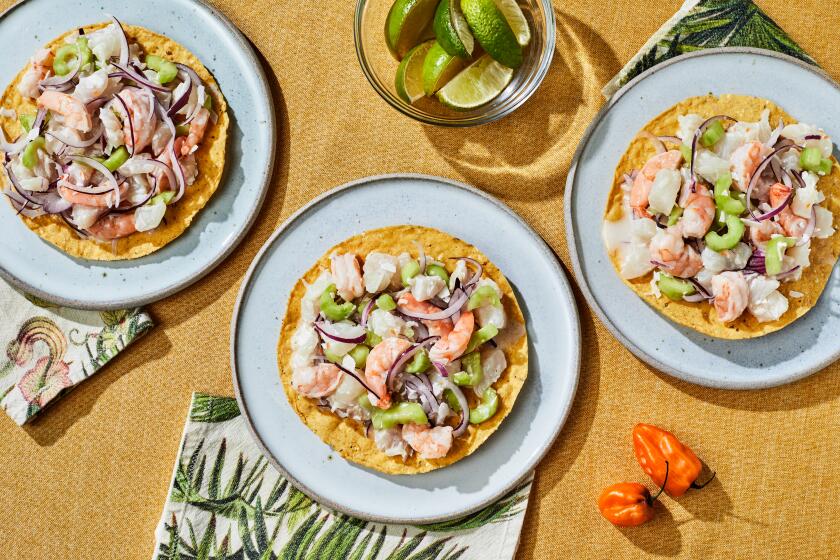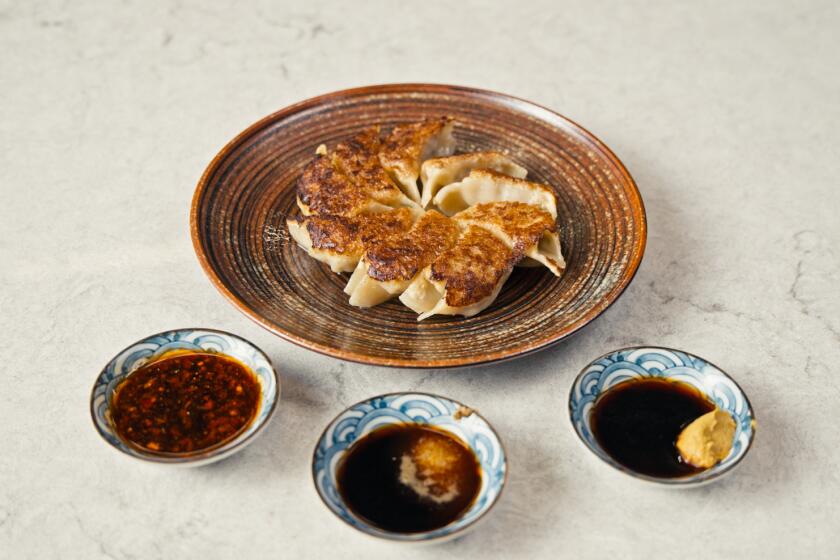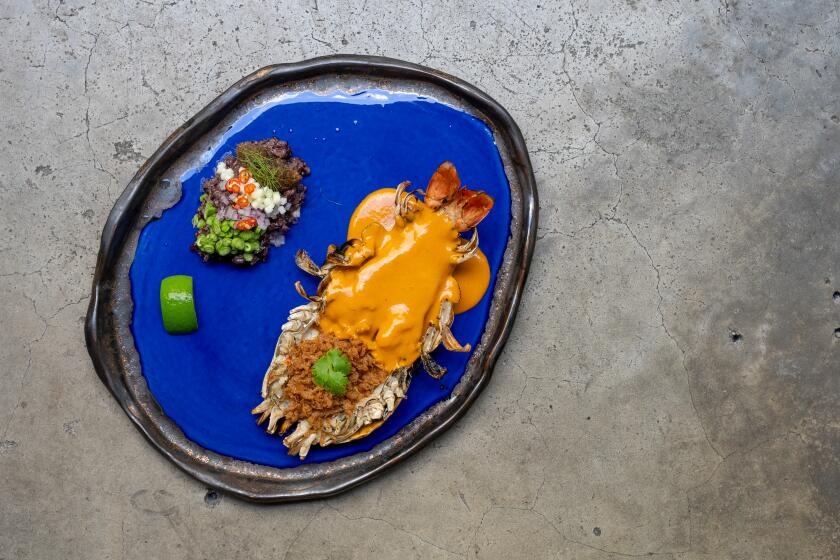Pumpkin tarte Tatin
This may sound un-American to say with the holidays coming, but I’m convinced that pumpkin is wasted in pie. Take away the sugar, take away the spice, take it out of a fresh shell rather than a shelf-stable can, and you’re looking at one of the most savory inspirations in the farmers market.
Old Europe certainly sees it that way. In France, Austria and especially Italy, pumpkin is rarely saved for dessert. Cooks in those countries, and probably many others that I have yet to discover, turn great pumpkin into ham-filled crepes and creamy soups and especially pastas, with lots of cheese, herbs and garlic -- all those accouterments that would put a stake through the Libby’s can.
Other parts of the world agree. You can’t order an arugula and goat cheese salad in Australia without finding chunks of spicy roasted pumpkin tucked among the leaves where the tomato should be. And in London, every restaurant currying vegetarian favor seems to be reaching for pumpkin in main courses like the savory tarte Tatin that has apparently displaced quiche as the steak alternative.
Like those foreign cooks, I think of pumpkin first and foremost as a hard squash, one of the most versatile ingredients of the season. Roast it, stuff it, braise it or saute it, and you always wind up with strong flavor and appealing texture.
But while other winter squashes, such as acorn and butternut, are hardy enough (and in enough demand) to hang around like walnuts all year, fresh pumpkins are a fairly ephemeral indulgence. The best of them, the little round ones called sugar pumpkins, are surprisingly perishable. They vanish from markets right around the time the nonedible jack-o’-lantern kind do. If you want to experience the difference, the time is now.
Pie lovers are probably objecting that pumpkin is a fruit. But so is the tomato. And while both fruits can be sugared, both are better spiced like vegetables.
My attitude changed about 10 years ago when I made my way to the “pumpkin capital of the world” to see the nation’s biggest harvest of the canned kind. The huge specimens in the fields around Morton, Ill., had an elongated shape and anemic color. They turned out to be a variety called Dickinson that dominates the industrial market because it has a low-moisture, deep-colored flesh suitable for canning.
The real revelation of the trip, though, was pumpkin chili. Someone had dreamed it up for the harvest festival in Morton, and it was my first realization that pumpkin could substitute for tomatoes and take on heavy heat as well. I returned home and made pumpkin risotto, and pumpkin gratin with Swiss chard. And I haven’t turned pumpkin into a pie very often ever since.
Like any squash in any season, pumpkin naturally goes with the kind of all-American ingredients Squanto could have taken to the first Thanksgiving table, particularly corn, beans, turkey, nuts and wild rice. It teams up harmoniously with other New World discoveries, like hot chiles and sweet peppers. And it really takes to vegetables that caramelize naturally as they cook slowly in butter and oil: onions, leeks and shallots. But pumpkin can also take a salty accent against its own sweetness, which is why goat and blue cheeses and tangy creme fraiche make far better garnishes than whipped cream.
I also like pumpkin with mushrooms, either real wild ones like morels or chanterelles, or cultivated “wild” ones like shiitakes, portobellos or creminis. Spicy sausage is also a natural partner, whether Spanish chorizo or Cajun andouille.
French flair
The French, who call pumpkin potiron, have perfected their own interpretations. I’ve seen it served with veal shanks and with scallops. In the Savoie region, it’s made into batter for crepes to fill with ham and Gruyere, and stuffed into cabbage leaves. When the French make a pie, they add onions instead of sugar.
Italians also go pumpkin crazy with what they call zucca, particularly around Parma. They season it with rosemary and sage, tuck it into ravioli and even fry it with anchovies. And they have the best understanding of how well pumpkin works with bechamel and lots of cheese, in either a gratin or lasagna.
Plain pumpkin, freshly baked and mashed, is actually pretty stunning all on its own. No one thinks to serve it that way, but it tastes like the flavor of fall, especially with fresh thyme.
Pumpkin also happens to be among the most trouble-free pieces of produce you can buy. The easiest way to wrangle it is to cut it in half, scrape out the seeds, lay it cut-side down on a baking sheet and forget it in the oven for about an hour. The flesh will caramelize as it softens, so that the flavor intensifies. All those recipes that advise adding water to the pan are steering you straight to the slow route to steaming, with only watery flesh in your future. (As I learned in the pumpkin capital, a ton of fresh pumpkin cooks down to 600 pounds.)
What you get from simple baking is very soft pumpkin that all but purees itself. The texture is more fibrous than the canned kind, but the flavor is much more vibrant. Cut a peeled pumpkin into cubes or slices, though, and it cooks faster and tastes more like a vegetable. Big chunks are an orange alternative to potatoes in stews.
If you want to double the pumpkin flavor, toss pumpkin cubes with a little pumpkin seed oil before you roast or saute them, or add pumpkin oil to a vinaigrette for an arugula salad.
Farmers markets these days deal in pumpkins in a cornucopia of sizes, shapes and colors. The main variety is the sugar pumpkin, also known as a pie pumpkin, which looks like a miniature jack-o’-lantern, with a bright orange shell and deep orange flesh. Cheese pumpkins are also widely available. They’re smaller variations on can-able Dickinsons, with a taupe skin and deep orange, relatively dry flesh. Sugar pumpkins have smoother shells and are easier to peel.
Even more prevalent are Jack-Be-Littles, pumpkins about fist size that clog supermarket produce aisles, but I prefer the grown-up kind with big flavor, serious yield and mature flavor.
Once pumpkin season ends, you can substitute other hard squash in recipes that call for it. Buttercups are my favorite, with their deep orange, deeply flavored flesh. When they go out of season, there are kabochas and hokkaidos, two Japanese varieties that are equally alluring, and the West Indian kind called calabaza. But even ordinary butternuts can work wonders in almost any pumpkin recipe. Even a pie.
As much as I’m convinced that pumpkins belong on the savory side of the menu, I really have nothing against the pie. I just think sweet potatoes do it so much better.
For the crust, combine the flour, salt and pepper in a mixing bowl and toss with a fork to mix well. Cut the chilled unsalted butter into one-quarter-inch pieces and rub into the dry ingredients with fingertips until the mixture resembles very coarse meal. Sprinkle with 2 tablespoons ice water and toss until the ingredients cling together, adding 1 tablespoon more water if necessary. Pull together into a ball and knead very lightly, then pat out into a thick round on wax paper. Wrap the dough in the wax paper and chill it while cooking the pumpkin.
Heat the oven to 375 degrees. Peel and seed the pumpkin and cut it into one-quarter-inch-thick slices.
Combine the olive oil and 2 tablespoons of the butter in a 10-inch (measured across the top) nonstick, ovenproof skillet over medium-low heat. Add the onion, salt to taste and half the thyme and saute, stirring often, until very soft and caramelized, about 20 to 25 minutes. Transfer to a bowl.
Wipe the skillet clean and add the remaining butter and the pumpkin seed oil; melt over medium heat. Arrange the pumpkin slices in the skillet in slightly overlapping layers, but with most of the pumpkin flat on the skillet so the surfaces will caramelize. The pumpkin should cover the bottom completely. Sprinkle with the remaining thyme and season with salt and pepper. Cook over medium-high heat until the bottom slices start to caramelize, about 5 minutes. Reduce the heat to the lowest setting, cover the skillet and cook until the pumpkin is soft but not falling apart, about 10 minutes. Drizzle with the cream and remove from the heat. Crumble the goat cheese and scatter the onions evenly over the pumpkin.
Cut a sheet of wax paper into a 10-inch round. On a lightly floured surface, roll out the dough under the sheet to make a crust, using the sheet as a guide. Remove the wax paper and carefully fit the crust over the pumpkin, tucking and crimping the perimeter to seal it completely.
Bake in the top third of the oven for 30 to 35 minutes, until the crust is browned. Using a small spatula around the edges of the skillet to release the crust, immediately unmold the tarte onto a serving platter (place a platter over the skillet and invert it). Cut it into wedges and serve warm or hot.
Get our Cooking newsletter.
Your roundup of inspiring recipes and kitchen tricks.
You may occasionally receive promotional content from the Los Angeles Times.















